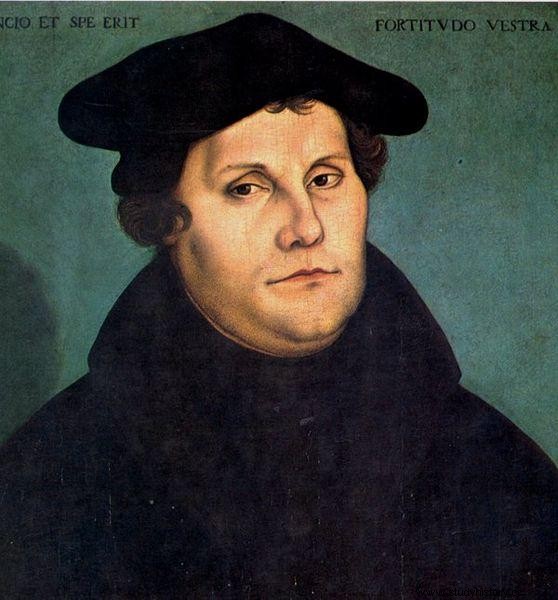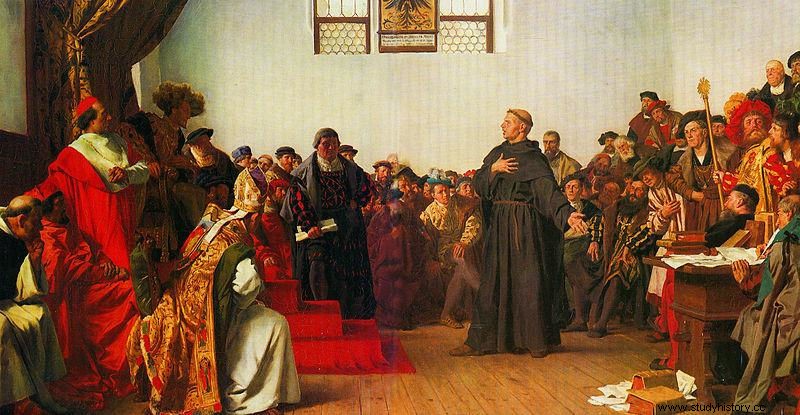Martin Luther began his life as a Catholic and died a heretic. He was an Augustinian monk, fervent in meditations and prayers , but died married to a former nun. The demand for indulgences was the main reason why Luther posted his 95 theses on the door of the Church of Wittenberg, criticizing what, according to him, were avaricious and pagan practices within the Catholic Church.
When starting the Protestant Reformation, Luther did not imagine that his ideas would motivate ruptures within the clergy and political use by kings and princes. your translation of the Bible for German it made it possible for the faithful to read and interpret Sacred Scripture .
Also read:Society of Jesus - Catholic Church's act of reaction against Protestantism
Martin Luther Biography
Martin Luther was born in Eisleben, Germany, November 10, 1483 . Son of Hans Luther and Margarethe Lindemann, he studied at the schools of Mansfeld, Magdeburg and Eisenach, as his parents wanted to see him as a civil servant to improve the family's financial conditions. In 1501, Luther enrolled at the University of Erfurt, where he graduated in Philosophy . In response to his mother's requests, he enrolled in law school at the same university.
Everything changed in Luther's life in 1505. As he was walking along a road towards his parents' house, a great storm struck with countless lightning streaking across the sky. An electrical discharge landed near him. Fearing for his life, Luther made a promise to Saint Anne that if the storm stopped, he would become a monk. As if heaven granted his request, the storm stopped and Luther fulfilled his promise by joining the Augustinian Order .
On entering the Augustinian Order at Frankfurt on July 17, 1505, Luther faithfully devoted himself to prayers, self-flagellation, and meditations . The more he devoted himself to the religious life, the more he felt the weight of his sins.
The superior of the order, Johann von Stauptuioz, realizing that Luther needed more work than just having a contemplative life, asked him to begin his academic career. In 1507,Luther was ordained a priest and the following year began to teach at the University of Wittenberg . In addition, he deepened his studies on Greek and Hebrew to better understand the words of the Bible.
Luther collaborated in the escape of 12 nuns who escaped from Nimbschen Convent. One of them, named Catarina Von Bora, married him on June 13, 1525. This marriage encouraged several priests and nuns to break their celibacy and marry. Shortly after his break with the Catholic Church, Luther translated the Bible into German, allowing any individual to read Holy Scripture without any mediation. The former monk died of natural causes on February 18, 1546 .
Martin Luther's Ideas
In the early 16th century, the Catholic Church was engaged in raising funds for the construction of St. Peter's Basilica in the Vatican. As the project was huge, the financial resources were also high. In order to attract more participation from the faithful and greater financial revenue, many bishops began to charge for Church services that, until then, were offered free of charge to the faithful. The indulgences , that is, the remission of sins, began to be charged .
It was not enough for the faithful to make sacrifices and live a penitent life, it was necessary to pay for the forgiveness of sins. This caught the attention of Luther when he realized the life of luxury and bonanza that the high clergy lived while the majority of the population was in misery . The penitent soul, the confession of sins and the pursuit of holiness were not worth more than a few coins deposited in the Church's coffers.
Protestant Reformation
On October 31, 1517, Martin Luther posted on the door of the Castle Church in Wittenberg 95 theses in which he questioned the worldly practices of the Catholic clergy , the avarice and paganism that, in his view, existed within the Church. The theses called for an ecclesiastical dispute over them. They quickly spread across Germany and gained adherents. Luther did not openly question the pope's authority to grant indulgences, but from the moment the theses were released, their initial purpose was interpreted according to the interests of the publicist.
The Church, soon after Luther posted his theses, in the early days, had not taken seriously what the Augustinian priest wanted. However, as the ideas began to become known, Pope Leo X appointed professor of theology Silvestro Mazzolini to answer them in an academic thesis.
When the reply was published,Luther responded to the theologian, initiating the debate on the authority of the Supreme Pontiff . As the controversy had no end and Luther's texts, because of the press, were quickly circulated,the pope excommunicated him on January 3, 1521 . For more details on this important historical event, read:Protestant Reformation.

Worms Diet
The Diet of Worms was an assembly held in the Holy Germanic Empire , in the city of Worms, of a deliberative character, and its decisions were valid for the whole empire. Emperor Charles V inaugurated the diet in 1521 and summoned Luther to the assembly to renounce or confirm his ideas.
On April 16, 1521, Luther attended the diet, and Johann Eck, assistant to the Archbishop of Trier, asked him to verify that the books displayed there were his and to confirm that he believed what was written in them. Luther asked for time to think about the answer, which he was granted.
The next day, he returned to the assembly and confirmed what he had written. The following days were marked by arguments over what fate Luther should have. Meanwhile, he fled from Worms, and the Emperor drew up the Edict of Worms, on May 25, 1521, considering him a fugitive and a heretic . His works were banned from the empire.

Summary on Martin Luther
- Martin Luther was an Augustinian monk and questioned the demand for indulgences by the high clergy of the Catholic Church.
- At the Diet of Worms, Luther was called upon to confirm or deny what he had written, and he confirmed it. This got him banished from the Holy German Empire.
- he married a former nun, which encouraged other religious to break their celibacy.
- He made the first translation of the Bible into German.
See also:Invention of printing – determining factor in the spread of biblical translation
Resolved exercises
Question 1 – Mark the alternative that correctly corresponds to the Lutheran criticism of the practices of the Catholic clergy:
A) collecting indulgences
B) divinity of Jesus Christ
C) Mary's virginity
D) revocation of the Council of Trent
Resolution
Alternative A. Martin Luther was a staunch critic of the Catholic Church's demand for indulgences because it devalued the confession of sins and the pursuit of a life of holiness.
Question 2 – It was in an edict that Emperor Charles V declared Luther a fugitive from the Holy Roman Empire and a heretic, this was the :
A) Edict of Milan
B) Edict of Saint Anthony
C) Vatican Edict
D) Edict of Worms
Resolution
Alternative D. The Diet of Worms was an assembly, convened by the Holy Roman Emperor, which deliberated decisions whose effects were valid throughout the empire. The Edict of Worms of May 1525 condemned Luther and forced him to flee the Germanic empire to preserve his life as well as his ideas.
